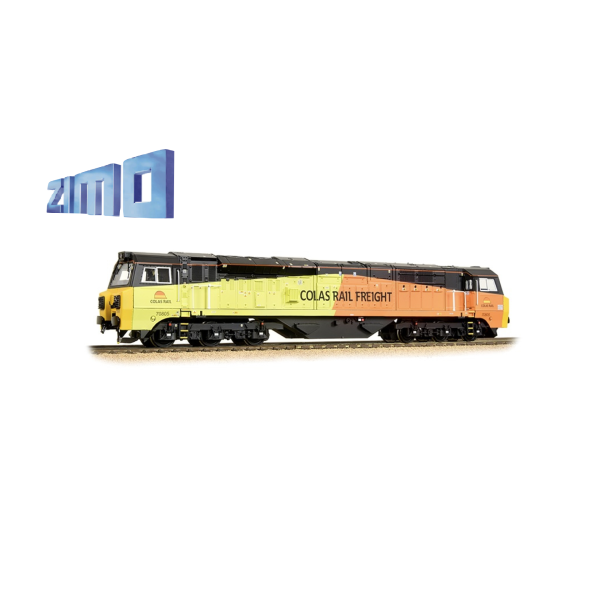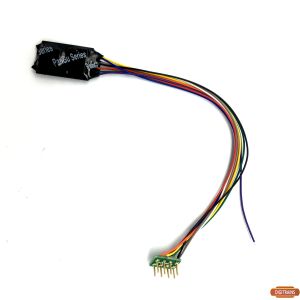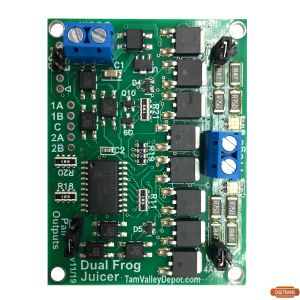ZS70ASL Digitrainsound Class 70 ActiveDrive Speed-lock.
Please spend a few moments to read these notes which have been produced so that you may obtain the maximum satisfaction from your new sound scheme.
The sounds should work perfectly when the decoder is fitted correctly. Individual locos may require some fine tuning that you can achieve with your DCC controller.
What is ActiveDrive?
This is a system developed to allow more prototypical sounds to be deployed across a wide range of operating conditions.
The sounds have been programmed in such a way that you, the user, may change the way that the sounds respond to your driving style or needs. This avoids the need for reprogramming and all the additional costs that would imply.
Engine Start Up.
F 1 will crank and start the engine which will then settle down into Idle.
Throttle Response Scheme.
As supplied, the decoder will produce the sounds of a Class 60 with a train on the hook.
After the start-up routine the loco will stand with the diesel engine, the Prime Mover (PM), ticking over at idle.
The sounds will respond to the throttle control in the following way:
Select speed step 1. The brakes will release, the PM will increase power to get the loco moving, and will continue until at higher speed, a further ramp up will be initiated until the final high speed running sounds begin. The precise speed steps will depend upon your model, so I suggest you make a note of the actual figures for your later use.
The sounds will spool down at similar points on deceleration.
The model can be driven in this way without ever needing to use any control other than the throttle .
For those of you who prefer something more immersive, in this custom version there are extra control features to further enhance your driving pleasure.
Coasting
No matter what actual speed your model is travelling at, or which engine note range is playing, reducing the throttle by 10 speed steps (of 128) will spool down the engine sounds to ‘Coasting’
The coasting sound will continue until you accelerate; at which point the sounds will change to those relevant to the current speed.
Alternatively, to force the engine to play idling sounds, or to avoid engine ramp up when pottering about the yard, use F6 at any time
Notch Down
During any driving sound ‘loop’, at any speed, it is possible to cause the engine power to spool down to the level immediately below. This is easily achieved by reducing the speed by one step only E.g., if the loco is playing power band 3 sounds, reducing speed with your throttle by one step will cause the sound to immediately spool down to the sound of power band 2, if in power band 1, it will spool down to idle.
Acceleration of one speed step or more will immediately ramp the sound back up to the higher power. So you can now, at any road speed, vary the engine note by reducing or adding a single speed step.
Heavy Train/Light Engine Mode Selection
The default setting is for ‘heavy train’. Inertia is high so acceleration (and deceleration) is restricted.
Activated by F5, Light Engine enables multi-function changes with one key. The switched features include reduced inertia setting to allow more rapid acceleration and engine sounds which accelerate differently.
F5 can be operated at any speed to give another way in which the engine sounds at a given road speed may be modified instantly.
Note. This works best if you switch F5 on or off whilst the engine sounds are playing in idle. Once switched, you can leave it that way, but any further change should also be made with the engine sound again playing the idle loop. Just to be clear, the actual speed is unimportant, but the engine sound must be idling. You can achieve this in several ways as discussed above.
Dynamic Inertia
A combination of new features is included in the automatic operation of the throttle which will affect how the model responds to your control inputs.
The operation is identical in either ‘heavy’ or ‘light’ mode.
Put in simple terms, the wider you open the power controller, the quicker the engine sounds ramp up and for the first time on any decoder, the acceleration rate increases correspondingly.
What does this mean in practice?
If you use your controller’s throttle gently, with modest speed step increases, then the engine will rise and fall automatically and the model will accelerate according to the momentum setting. This is by default high for ‘heavy’ and low for ‘light’.
If however, you open the throttle rapidly, the engine will ramp up to full power and acceleration will be approximately 3 times quicker. This change in acceleration rate is variable and dependent upon throttle operation.
Brakes
F2 will give the sound of air brake applications. They can be ‘dabbed’ or held for varying length. The sound will respond accordingly.
However, if the throttle is reduced beforehand, as a real driver would do before braking, a braking force will be applied which will continue to increase the longer F2 is held. Short dabs will provide speed trimming, held down continuously will result in a controlled ‘Emergency Stop’.
PowerCab users please note that the Horn/Whistle button operates the same sound/function as the F2 Key, but set as ‘momentary’. This facilities the precise operation of the brakes and should be used instead of F2.
Other systems may have F2 set to operate as ‘momentary’ by default, or can be set to do so.
Engine Speed-up
F7 is a complementary key to F6. Whilst the latter forces the engine sounds to Idle, F7 will speed up the engine to maximum. Since this includes the sound of the traction motors, this should only be used when the loco is in motion.
Remember to switch this key off before stopping!
Live Volume Control
Provided the sound is switched on and the ‘fade’ button is not active, it is possible to change the overall volume to suit changing needs.
Engage F27 and the sound levels will gradually reduce, eventually to silence
Engage F28 and the sound levels will gradually increase, eventually to maximum.
In each case, disengage the F key when the desired level is attained. Set F27 and F28 as ‘momentary’ if your DCC controller allows you to do so.
Note: If the volume controls appear to not function, check that F19, F27 and F28 are disengaged before making a further attempt.
It’s now down to your skill and knowledge to simulate any eventuality!
Function List
|
F Key
|
Function/Sound
|
Volume
Setting CV
|
|
0
|
Lights
|
-
|
|
1
|
Sound On/Off
|
-
|
|
2
|
Brake Key (see text)
|
517
|
|
3
|
Horn
|
520
|
|
4
|
Horn
|
523
|
|
5
|
Light Engine
|
-
|
|
6
|
Engine Idle
|
-
|
|
7
|
Speed lock
|
-
|
|
8
|
Cabights FO1
|
535
|
|
9
|
Flange Squeal
|
538
|
|
10
|
Horn
|
541
|
|
11
|
Horn
|
544
|
|
12
|
Park brake
|
547
|
|
13
|
Primer
|
550
|
|
14
|
Door
|
553
|
|
15
|
Hiss
|
556
|
|
16
|
Air release
|
559
|
|
17
|
Compressor
|
562
|
|
18
|
Skipfire
|
565
|
|
19
|
Fade All Sounds
|
-
|
|
20
|
Reserved
|
-
|
|
21
|
Reserved
|
-
|
|
22
|
Reserved
|
-
|
|
23
|
Reserved
|
-
|
|
24
|
Reserved
|
-
|
|
25
|
Reserved
|
-
|
|
26
|
Reserved
|
-
|
|
27
|
Volume Down
|
-
|
|
28
|
Volume Up
|
-
|
CV Table that follows is a summary of the common user CVs. A complete CV table will be found in the small decoder user manual available for download from the ZIMO Website.
|
CV
|
Designation
|
Range
|
Default
|
Description
|
|
1
|
Sort Address
|
1 - 127
|
3
|
Active when Bit 5 in CV29 = 0
|
|
2
|
Start Volts
|
1 - 252
|
1
|
Value at speed step 1. Only applies if Bit 4 of CV29 = 0 otherwise the individual speed table is active.
|
|
3
|
Acceleration
|
0 - 255
|
2
|
Multiplied by 0.9 equals time in seconds from stop to full speed.
Influenced by sound project.
|
|
4
|
Braking
|
0 - 255
|
1
|
Multiplied by 0.9 equals time in seconds from full speed to stop.
Influenced by sound project.
|
|
5
|
Top Volts
|
0 - 252
|
1
|
Level applied to the highest speed step in use. Value 0 and 1 = max. Bit 4 in CV # 29 has to be 0 or the individual speed table is active.
|
|
6
|
Mid Volts
|
1
A useful value for CV 6 is ¼ to ½ of the value in CV5
|
1
Default = about 1/3 of top speed
|
Entered value = internal speed step assigned to the cab’s centre speed step (=step 7,14 or 63 according to the number of speed steps selected: 14, 28 or 128)
Bit 4 in CV # 29 has to be 0 or the individual speed table is active
|
|
8
|
Manufacturer ID
and factory reset
|
Read Only
|
145
= ZIMO
|
Setting CV 8 to a value of 8 or 0 will return all CVs to the manufacturer’s default settings. Address = 3
|
|
17 & 18
|
Long Address
|
128 - 10239
|
0
|
The long 5-digit primary address (greater than 127). This address is only active when Bit 5 in CV 29 is on. Otherwise the address entered in CV 1 is active (127 or lower).
|
|
29
|
Basic Configuration
CV #29 is calculated by adding the value of the individual bits that are to be “ON”:
Values added together to turn Bits “ON”:
Bit 0: 1
Bit 1: 2
Bit 2: 4
Bit 3: 8
Bit 4: 16
Bit 5: 32
Bit 6: not used
Bit 7: not used
|
0 - 63
|
14
This means that bits 1,2 and 3 are turned on. The loco runs on 28/128 speed steps, DC enabled and RailCom active.
|
Bit 0 - Train direction:
off = normal, on = reversed
Bit 1 - Number of speed steps:
off = 14, on = 28
Note: 128 speed steps are always active if corresponding DCC packets are received!
Bit 2 - DC operation (analog): *)
off = disabled on = enabled
Bit 3 - RailCom („bidirectional communication“)
off = deactivated on = activated
Bit 4 - Individual speed table:
nff = CVs # 2, 5 and 6 are active.
on = individual speed table is used as set in CVs 67 – 94.
Bit 5 - Decoder address:
off = short address as per CV 1
on = long address as per CV 17+18
|
|
266
|
Volume
|
0 -255
|
65
|
The recommended range for use without distortion is 0 – 65. Settings above 65 are available subject to experimentation.
|
|
267
|
Chuff Frequency with virtual sensor for steam sound.
|
0 - 255
|
70
|
Active if CV268 value = 0 (Default)
Sets the duration between chuffs; lower settings = more chuffs.
|
|
268
|
Real cam settings
|
0 - 255
|
0
|
Default = 0 off; CV267 is active.
1 = real cam sensor is active at 1 chuff per trigger
|
Troubeshooter If decoder appears faulty at any time carry out a project reset setting CV8 to 0. This will restore your decoder to as shipped condition. It will also reset address to 3 again, original sounds will not be lost.





